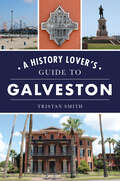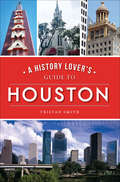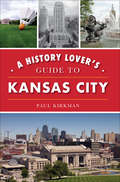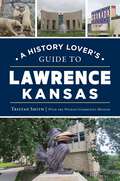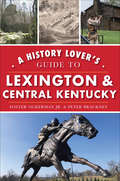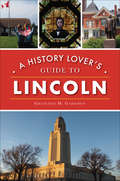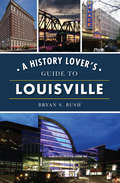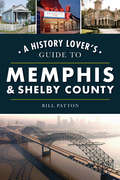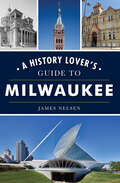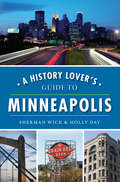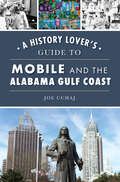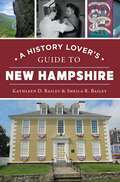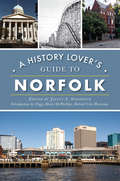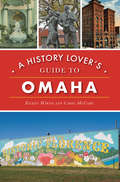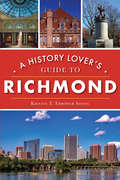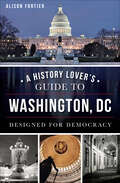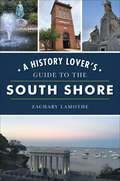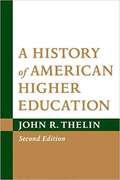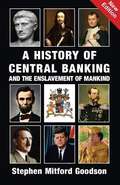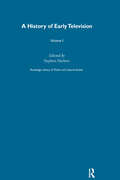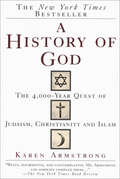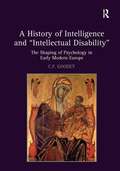- Table View
- List View
A History Lover's Guide to Galveston (History Lovers Guide)
by Tristan SmithA guide through the history of the Playground of the Southwest. Established in 1839, Galveston was the largest city in Texas for much of the state's early history. The island city has hosted the likes of Cabeza de Vaca, Jean Lafitte, Sam Houston, Jack Johnson, King Vidor, and Sam Maceo. A strategic target during the Civil War and military stronghold during both World Wars, Galveston endured through countless calamities, including the most damaging hurricane to hit the United States. From historic mansions to long-hidden outposts of the vice district, author Tristan Smith surveys the best places to catch a glimpse of the Oleander City's past, whether that comes in the form of museum treasure or Seawall panorama.
A History Lover's Guide to Houston
by Tristan SmithA guide to the history of the Bayou City for Texans, visitors and armchair tourists alike.Houston earned its international reputation as a hub for space flight and the oil industry. But visitors don't need to search out the secrets of the stars or the depths of the earth to experience the impressive legacy of the nation's fourth-largest city. Traverse the streets of downtown and find historic treasures from antebellum Texas. Venture to the outskirts to find the world’s “Eighth Wonder,” as well as the globe’s tallest stone monument and one of its largest ports. Discover why the town’s exceptional heritage of innovation, industry and architecture has sparked a movement to uncover and embrace its historic structures. Join Tristan Smith for an in-depth exploration of Houston’s historic wards.
A History Lover's Guide to Kansas City (History & Guide)
by Paul KirkmanDiscover the sights, sounds, and rich history of Kansas City—from ancient burial mounds to a world-class jazz museum.Kansas City is often seen as a “cow town” with great barbecue and steaks. But it’s also a city with more boulevards than Paris and more working fountains than Rome. There are burial mounds that date back more than two thousand years. The National World War I Museum and Memorial, opened in 1926, stands more than two hundred feet tall. Leila’s Hair Museum has a collection that brings tourists from all over the nation. The Kansas City Jazz Museum features a historic district and world-class museum that document a time when dance halls, cabarets, speakeasies, and even honky-tonks and juke joints fostered the development of a new musical style. Join Missouri historian Paul Kirkman as he cuts a trail past the stockyards and takes you on a tour into the heart of America—Kansas City.Includes photos and information on Kansas City landmarks
A History Lover's Guide to Lawrence, Kansas (History & Guide)
by Tristan SmithExplore and Learn LFKLawrence was founded in 1854 by the New England Emigrant Aid Company, and it has a bevy of historical locations for visitors. Downtown’s infamous Mass Street was nearly destroyed twice by warmongering guerrillas like William Quantrill. It was central to the era of John Brown and Bleeding Kansas and the site of the Wakarusa War. From famous beat writer William Burroughs to poet Langston Hughes, vaudeville actor George “Nash” Walker and basketball inventor James Naismith, the city has been home to a great slice of American historical figures and events. Uncover some familiar landmarks as well as some hidden gems as Tristan Smith, with the help of the Watkins Community Museum, takes readers through Lawrence’s unique landscape.
A History Lover's Guide to Lexington & Central Kentucky (History & Guide)
by Peter Brackney Foster Ockerman Jr.“Give[s] a history of Lexington and the region with a special focus on the historic neighborhoods of Lexington and historic sites around the Bluegrass.” —The KaintuckeeanThe Athens of the West. The Horse Capital of the World. The Home to the Greatest Tradition in College Basketball. Heart of the Bluegrass. Lexington has a lot of names and an even richer history. The region played an oversized role in America’s educational, political, religious and cultural development. Visit a historic AME church in downtown Lexington that was a stop on the Underground Railroad for escaping slaves. Walk through fifteen local historic districts. Explore an equine cemetery. Join historians Foster Ockerman Jr. and Peter Brackney on a tour through historic sites and buildings in Lexington and central Kentucky.
A History Lover's Guide to Lincoln (History & Guide)
by Gretchen M. GarrisonA neighborhood-by-neighborhood tour of the Cornhusker State’s capital city by an author who “is a wealth of Nebraska knowledge” (Oh My! Omaha).Dramatic change accompanied Lincoln’s growth from a village of 30 settlers to a city of 300,000. Today, Lincoln retains the residue of its fascinating past for those who know where to look. Tour Lincoln’s storied heritage by charting the arrival of the university, penitentiary, asylum and railroads. Learn how the early churches still anchor the community. Discover the five towns that later merged into Lincoln. Visualize the artwork that best reflects Lincoln—both the person and city. Locate where Lindbergh learned to fly. Revisit the downtown Lincoln scene of what was once the largest bank robbery in the United States. Picture the once thriving Capitol Beach Amusement Park. Explore Nebraska’s capital city in the expert company of Gretchen M. Garrison.
A History Lover's Guide to Louisville (History & Guide)
by Bryan S. BushGateway to the South. Home of the Kentucky Derby and Churchill Downs. Louisville has a rich history, beginning with the city's discovery by General George Rogers Clark. The city played an important role in the Civil War, and during the Gilded Age, it became the Bourbon Capital of the World. During World War I, the city hosted 47,500 troops at Camp Zachary Taylor. During World War II, the U.S. Naval Ordnance Plant contributed to the war effort, making rounds for big guns during the late war. Author Bryan S. Bush takes the reader on a journey to discover the history of Louisville through the historic sites and locations from far past to the present day.
A History Lover's Guide to Memphis & Shelby County (History & Guide)
by Bill PattonThis tour of Memphis goes well beyond the traditional guidebook to offer a historical journey through the Home of the Blues. Explore the city's African American heritage from Church Park to beautiful Mason Temple, where Dr. Martin Luther King Jr. delivered his final, prophetic speech. Visit Court Square, where a young Thomas Edison delighted children and adults with his popular invention: the cockroach shocker. Discover hidden gems like the nineteenth-century dueling grounds on the banks of the Mississippi and a charming Depression-era country store. From Beale Street to the bluffs, author Bill Patton traces the incomparable history of Memphis.
A History Lover's Guide to Milwaukee (History & Guide)
by James NelsenMilwaukee is often described as a "big small town," and its quirky character stems from its many neighborhoods--each with its own stories to tell. Early territorial disputes, for example, led to the horribly (or humorously) misaligned streets of downtown. The city's signature rectangular pizza was born in the Third Ward. In Kilbourntown, Teddy Roosevelt was saved from an assassin's bullet by the smallest of items. Not far from that spot, eight baseball team owners formed the American League of Professional Baseball Clubs. And no matter the neighborhood, a fantastic glass of suds is never far away in this renowned beer city. Leading readers on a neighborhood-by-neighborhood tour, author and Milwaukee native Jim Nelsen pinpoints the fascinating historic locations of the Cream City.
A History Lover's Guide to Minneapolis (History & Guide)
by Holly Day Sherman WickMinneapolis began at the Falls of St. Anthony, the sole waterfall on the Mississippi River. The cataract, the great hydrological engine, propelled the city's economic growth and physical expansion, and two distinct municipal identities emerged. A city of seasons, Minneapolis celebrates winter flurries and chills with ice skating and hot chocolate at the annual Holidazzle Festival. In the sultry midsummer heat, the Aquatennial brings swimmers and boating enthusiasts to the Chain of Lakes and the river. Landmarks, too, define the topography-Spoonbridge and Cherry, the Stone Arch and Hennepin Avenue Bridges, the Foshay Tower and the IDS Center. Join local authors Sherman Wick and Holly Day on a trip beyond the typical guidebook as they explore the architecture, parks and historical figures of the Mill City.
A History Lover's Guide to Mobile and the Alabama Gulf Coast (History Lovers Guide)
by Joe CuhajLocated almost dead center along the Gulf Coast, Mobile has seen a thing or two in its long history. The Port City has survived the ravages of hurricanes and yellow fever epidemics. It has been handed down from one nation to another not once but several times. The last major battle of the Civil War roared only miles away across its namesake bay, a few short years after the last slave ship, the Clotilda, arrived with its human contraband. But this city has had much to celebrate, as well. Mobile gave our nation its greatest party--Mardi Gras. It was also the birthplace of five Major League Baseball Hall-of-Famers. Author Joe Cuhaj serves as docent to the twists and turns of Mobile and the Alabama Gulf's fascinating past.
A History Lover's Guide to New Hampshire (History Lovers Guide)
by Kathleen D. BaileyUniquely New HampshireNew Hampshire has always been fiercely independent, and its history, museums and festivals reflect that trait. Roy Campanella and Don Newcombe broke baseball’s color barrier with the Nashua Dodgers in 1946, and Holman Stadium is now a stop on the Black Heritage Trail. Three of the state’s historic mansions—the Fells, the Castle in the Clouds and the Saint-Gaudens historic site—remain as impressive today as when they were built. Portsmouth’s historic homes give a portrait of life in colonial and Revolutionary times. From the New England Telephone Museum in Warner to the Exeter UFO Festival, the state has a wealth of history on display. Kathleen D. Bailey and Sheila R. Bailey lead a trip through the past and present of the Granite State’s most memorable sites.
A History Lover's Guide to New York City (History And Guide Ser.)
by Alison FortierThis guidebook to the Big Apple goes beyond the traditional tour, offering visitors a fascinating exploration of the city&’s rich history. New York is a city of superlatives. It has the largest population, greatest wealth, broadest diversity, and most elegant museums in the nation. With that comes an amazing history that you can experience firsthand with this unique guide. George Washington took his first oath of office on the steps of Federal Hall. Visitors can still dine at the famed Fraunces Tavern and worship at historic St. Paul&’s Chapel. From the Brooklyn Bridge to stunning skyscrapers, the city celebrates its own history and that of the nation. Join author Alison Fortier as she traces the history and heritage of America&’s largest metropolis.
A History Lover's Guide to Norfolk (History & Guide)
by Jaclin A. SpainhourBegun in the seventeenth century as a small settlement nestled along the Elizabeth River, Norfolk had grown into a vibrant port city by the Revolutionary War. The city spread out from early neighborhoods like the Freemason District into nineteenth-century enclaves like Ghent along the Hague. Twentieth-century Norfolk was marked by its development into a bustling Navy town. Journey through the vibrant past of this multifaceted locale, guided by expert authors from local museums, historical organizations and city institutions. Walk the city's most historic neighborhoods and learn the history of its beachside communities. End with suggestions of places to eat and play that evoke traces of Norfolk's past. Crack open these pages to learn that Virginia is truly for history lovers.
A History Lover's Guide to Omaha
by Eileen Wirth Carol McCabeIn Omaha, an evening stroll can provide passage into a fascinating past. Travel from a madam's elaborate grave in North Omaha to the site of the first U.S. airmail flight in Aksarben. Chase down the echoes of a Duke Ellington performance at the Dreamland Ballroom in the Jewell Building. Stow away on a tour that treats the whole city like a museum. Colorful street murals and Gilded Age mansions stand in as exhibits alongside the more traditional offerings of state markers and archival collections. Gain fresh appreciation for familiar landscapes and famous landmarks as Eileen Wirth and Carol McCabe move through Omaha neighborhood by neighborhood.
A History Lover's Guide to Richmond (History & Guide)
by Kristin T. StoweBest known as the capital of the Confederacy, Richmond's history encompasses much more than the Civil War. Visit the state capitol, designed by Thomas Jefferson, and tour Shockoe Bottom, one of the city's oldest neighborhoods. Follow the route that enslaved people took from the ships to the auction block on the Richmond Slave Trail. Go back to Gilded Age Richmond at the Jefferson Hotel and learn the history of the statues that once lined the famed Monument Avenue. See lesser-known sites like the Maggie Walker Home and the Black History Museum in the historically African American Jackson Ward neighborhood. Local author Kristin Thrower Stowe guides a series of expeditions through the River City's past.
A History Lover's Guide to Washington, DC: Designed for Democracy (History And Guide Ser.)
by Alison FortierExperience the history of America&’s capitol with this uniquely engaging and informative guidebook. Alternating between site visits and brief historical narratives, this guide tells the story of Washington, DC, from its origins to current times. From George Washington&’s Mount Vernon to the Kennedy Center, trek through each era of the federal district, on a tour of America&’s most beloved sites. Go inside the White House, the only executive home in the world regularly open to the public. Travel to President Lincoln&’s Cottage and see where he wrote the Emancipation Proclamation. And visit lesser-known sites, such as the grave of Pierre L&’Enfant, the city&’s Botanical Gardens, the Old Post Office, and a host of historical homes throughout the capital. This is the only guide you&’ll need to curate an unforgettable expedition to our shining city on a hill.
A History Lover's Guide to the South Shore (History & Guide)
by Zachary LamotheA guide to the history of the Massachusetts region for visitors, locals and armchair tourists alike.The South Shore is an intriguing mix of antiquity and modernity. The region’s first settlement, Plymouth, is a top tourist destination, as more than one million visitors flock to it annually. Quincy showcases the region’s Revolutionary War past, but even more of its fascinating sites are hidden behind an urban façade. Along windswept beaches and cranberry bogs, the varied terrain is unique and captivating. From the birthplace of Abigail Adams in Weymouth to the historical houses of Hingham and the Old Scituate Light, author Zachary Lamothe uncovers the stories behind some of the most notable people and landmarks in New England.
A History Of American Higher Education
by John R. ThelinColleges and universities are among the most cherished―and controversial―institutions in the United States. In this updated edition of A History of American Higher Education, John R. Thelin offers welcome perspective on the triumphs and crises of this highly influential sector in American life. Thelin’s work has distinguished itself as the most wide-ranging and engaging account of the origins and evolution of America's institutions of higher learning. This edition brings the discussion of perennial hot-button issues such as big-time sports programs up to date and addresses such current areas of contention as the changing role of governing boards and the financial challenges posed by the economic downturn.
A History Of Central Banking And The Enslavement Of Mankind
by Stephen Mitford GoodsonA History of Central Banking and the Enslavement of Mankind is Stephen Mitford Goodson’s companion volume to Inside the South African Reserve Bank Its Origins and Secrets Exposed. While the latter volume describes the mechanics of the fraudulent usury banking system, with a focus on Goodson’s experiences as a director of the SA Reserve Bank, this volume expands the focus to encompass the role of banking and money in history from ancient times to the present. <p><p> The role of money-lenders in history was once aptly termed by many acute observers as the “Hidden Hand.” It is the power to create, lend and accumulate interest on “credit,” and then re-lend that interest for further interest, in perpetuity, that creates pervasive, worldwide debt, from the individual, to the family, to the entire state. The ability to operate a fraudulent credit and loan system has long been known, and through all the slickness of a snake-oil salesman, the money-lenders – the same types Jesus whipped from the Temple – have persuaded governments that banking is best left to private interests. <p> Many wars, revolutions, depressions, recessions, and other social upheavals, have been directly related to the determination of these money-lenders to retain and extend their power and profits. When any state, individual or idea has threatened their scam they have often responded with wars and revolutions. The cultural and material progress of a civilization will often relate to the degree by which it is free from the influence of debt, and the degradation that results when the money-lenders are permitted to regain power. Hence, Goodson shows that both World Wars, the Napoleonic wars, the American Revolution, the rise and fall of Julius Caesar, the overthrow of Qathafi in Libya and the revolution against Tsar Nicholas, among much else relate to this “Hidden Hand” in history. This is the key to understanding the past, present and future.
A History Of Christian Education
by James E. Reed Ronnie ProvostOurs is an age of rapid change. What is fashionable comes and goes more quickly than ever before. In a world of such rapid change, it's essential to know who you are--to know where you come from, to have your roots go deep. Walking through this book is like going to a large family reunion and meeting for the first time some relatives you didn't know you had. Here in all of its richness and diversity is your family of faith. Of course, the roots of Christian education go deep into the Hebrew heritage. In many ways, Christian education is an extension of Hebrew education.
A History Of Early Television Vol 1
by Stephen HerbertIn the 21st Century, broadcast television is an established part of the lives of many millions of people all over the world, bringing information and entertainment directly into our homes. The pieces in this volume date from 1879 to 1934 and consist of a selection of books, articles and news items relating to the first developmental period of television, before it became the ubiquitous medium that we know today. The selection is English language material only.
A History Of England: 1688 To The Present
by David Roberts Clayton Roberts Douglas R. BissonFor two-semester, junior/senior-level courses in the History of England. Volume II may be used for a one-semester course in Modern England. <P><P> This two-volume broad, narrative account of English history–from the first settlers in the Paleolithic Age to the present day–draws on the most up-to-date primary and secondary research to illuminate the full range of England's social, economic, cultural, and political past, and focuses on how and why events occurred.
A History Of God: The 4,000-Year Quest of Judaism, Christianity and Islam (Readers Circle Ser.)
by Karen ArmstrongIn this stunningly intelligent book, Karen Armstrong, one of Britain's foremost commentators on religious affairs, traces the history of how men and women have perceived and experienced God, from the time of Abraham to the present. From classical philsophy and medieval mysticism to the Reformation, the Enlightenment, and the modern age of skepticism, Karen Armstrong performs the near miracle of distilling the intellectual history of monotheism into one superbly readable volume, destined to take its place as a classic.
A History Of Intelligence And 'intellectual Disability': The Shaping Of Psychology In Early Modern Europe
by C. F. GoodeyStarting with the hypothesis that not only human intelligence but also its antithesis 'intellectual disability' are nothing more than historical contingencies, C.F. Goodey's paradigm-shifting study traces the rich interplay between labelled human types and the radically changing characteristics attributed to them. From the twelfth-century beginnings of European social administration to the onset of formal human science disciplines in the modern era, A History of Intelligence and 'Intellectual Disability' reconstructs the socio-political and religious contexts of intellectual ability and disability, and demonstrates how these concepts became part of psychology, medicine and biology. Goodey examines a wide array of classical, late medieval and Renaissance texts, from popular guides on conduct and behavior to medical treatises and from religious and philosophical works to poetry and drama. Focusing especially on the period between the Protestant Reformation and 1700, Goodey challenges the accepted wisdom that would have us believe that 'intelligence' and 'disability' describe natural, trans-historical realities. Instead, Goodey argues for a model that views intellectual disability and indeed the intellectually disabled person as recent cultural creations. His book is destined to become a standard resource for scholars interested in the history of psychology and medicine, the social origins of human self-representation, and current ethical debates about the genetics of intelligence.
